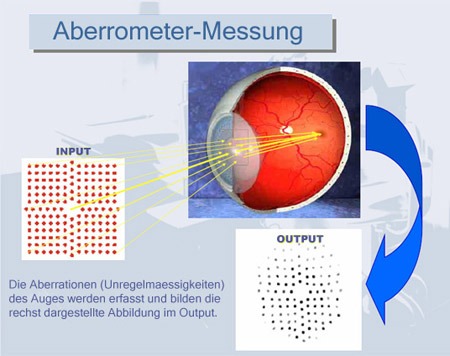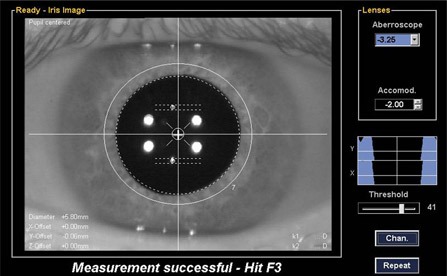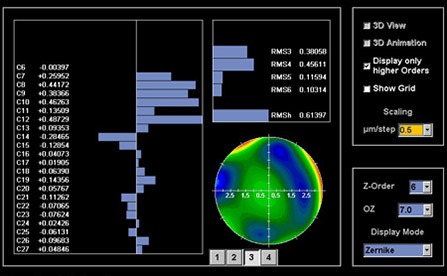Aberrometry / Wavefront
Aberrometry/Wavefront technology measures and corrects the eye’s optical imperfections precisely. It uses wavefront aberrometry to create a detailed map of light waves traveling through the eye, enabling customized evaluation and treatment.
How Aberrometry / Wavefront Technology Works
- Light Projection: A beam of light projects into the eye and reflects back out.
- Wavefront Mapping: The reflected light is analyzed to create a wavefront map, which shows how the light waves are distorted as they pass through the eye. These distortions, or aberrations, are represented graphically.
- Analysis: The aberrometry / wavefront analyzer breaks down the map into high- and low-order aberrations. Low-order aberrations include common vision problems like nearsightedness, farsightedness, and astigmatism. High-order aberrations are more complex and can affect night vision, contrast sensitivity, and overall clarity.
Applications of Aberrometry / Wavefront Technology
- Customized LASIK Surgery:
Wavefront-guided LASIK uses this technology to create a personalized treatment plan. By addressing both low- and high-order aberrations, it aims to provide superior visual outcomes compared to standard LASIK.
- Vision Correction:
Custom contact lenses and eyeglasses can be crafted based on wavefront data to improve vision quality beyond traditional prescriptions.
- Diagnostics:
Eye care professionals use wavefront technology to diagnose and track various optical aberrations, enhancing the precision of their assessments and treatments.
Benefits of This Technology
– Personalization: Allows for highly tailored treatments specific to each individual’s unique eye structure.
– Precision: Provides a detailed analysis of both simple and complex aberrations, leading to more accurate correction.
– Better Visual Outcomes: Can result in sharper vision with less glare and improved night vision, particularly in low-light conditions.
Wavefront technology represents a significant advancement in the field of optometry and ophthalmology, offering precise, personalized, and effective solutions for a wide range of vision issues.
Summary
Until 5-6 years ago visual disorders had been defined as hyperopia, myopia and astigmatism. However, visual defects can now be more precisely measured currently with the rapid advancement in technology, and these measurements can be obtained as mathematical data. This technology has been approved by FDA (Food and Drug Administration).
Aberrometer is a diagnostic tool that detects refractive errors of the human eye both objectively and qualitatively. Wavefront-Lasik or Lasek application is determined according to the results of Aberrometer.
Hence, it is possible to perform individualized and optimized laser treatment due to cutting-edge technology and opthalmological diagnoses. Aberrometry obtains all necessary data. (it shows refractive error of the whole eye).
 With Aberrometry application, light is given to the eye and the anterior waves of small optic sensors that reflect back are measured. Thus, all errors of light are calculated and a wave map is established. With this application, total refraction defect of the optic system is visualized graphically.
With Aberrometry application, light is given to the eye and the anterior waves of small optic sensors that reflect back are measured. Thus, all errors of light are calculated and a wave map is established. With this application, total refraction defect of the optic system is visualized graphically.
Process
Leyla Kandur, M.D. obtains data about your eye with all its specific differences and utilizes this information for individualized treatment. In this LASIK procedure supported by Aberrometer, visual ability in twilight settings can be improved. Improvement in comperative visual ability occurs.
We perform a very careful pre-examination of the eye to detect potential deformities or defects in the eye. In addition, the pupil is measured in the dark, and not only manual, but also computarized measurements are performed. We always select the largest possible area in laser treatment. This area should always be larger than the size of the pupil adapted to the dark. We always use laser with a Flying-Spot-Modus and a High-Frequenzy-Eyetracker together with a small spot up to 1mm.
Primarily, the beam is sent to the eye and accumulates right in the cornea.


A wave plane extends from the lens and cornea reflecting from this point.
This light wave which occurs is analyzed by Aberrometer: A lens system (Linsenarray) projects the light wave to CCD-Camera and the wave is calculated by a computer.
Refractive disorders are detected by intensity shifts and magnification-reduction-distortion effects of light points formed by Linsenarry ( for example, area and cylinder). Other factors which may affect the quality of reflection can also be detected.
It visualizes the eye perfectly (if there is no visual defect) and reflects the light as a flat wave plane. However, the light is reflected as an irregular wave plane, if visual defect is present.
Conclusion
Aberrations in the eye are not considered in correction of hypermetropia, myopia and astigmatism (as with eyeglases and contact lenses). However, in a laser treatment with Aberrometer, there is a possibility to correct aberrations as well. This application means improvement of visual ability without using eyeglasses and contact lenses.
Leyla Kandur, M.D. will inform you if you need an Aberrometer application after a detailed pre-examination.
